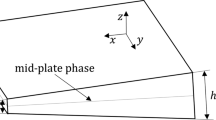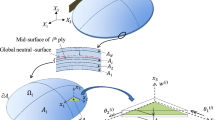Abstract
The virtual laminated element method (VLEM) can resolve structural shape optimization problems with a new method. According to the characteristics of VLEM, only some characterized layer thickness values need be defined as design variables instead of boundary node coordinates or some other parameters determining the system boundary. One of the important features of this method is that it is not necessary to regenerate the FE (finite element) grid during the optimization process so as to avoid optimization failures resulting from some distortion grid elements. The thickness distribution in thin plate optimization problems in other studies before is of stepped shape. However, in this paper, a continuous thickness distribution can be obtained after optimization using VLEM, and is more reasonable. Furthermore, an approximate reanalysis method named “behavior model technique” can be used to reduce the amount of structural reanalysis. Some typical examples are offered to prove the effectiveness and practicality of the proposed method.
Similar content being viewed by others
References
Fleury, C. and Sander, G., 1983. Dual methods for optimizing finite element flexural systems.Computer Methods in Applied Mechanics and Engineering,37(3): 249–275.
Imam, M. H., 1982. Three-dimensional shape optimization.Int J Numer Meth Engng,18: 661–673.
Kang, J. Z., Ye, D. Y., 1986. A feasible direction method for the optimum design of thin plate.Computational Structural Mechanics and Applications,3(3): 67–76 (in Chinese).
Ling, D. S., Zhang, J. J., Xiang, Y. Q. and Xu, X., 1998. The method of virtual laminated element and its application in bridge engineering.China Civil Engineering Journal,31(3): 22–29 (in Chinese).
Ramana, V., Grandhi and Geetha Bharatram, 1993. Multiobjective optimization of large-scale structures.AIAA Journal, 1993,31(7), 1329–1337
Sienz, J. and Hinton, E., 1997. Reliable structural optimization with error estimation, adaptivity and robust sensitivity analysis.Comput. & Struct.,64(1–4): 31–63.
Wu, Q., 1997. Finite element analysis for laminated structure with visco-elastic layer. Doctor's Thesis, Zhejiang University (in Chinese).
Xu, X. and Ling, D. S., 2001. Degenerated solid elements. ACTA MECHANICA SOLIDA SINICA, Special issue for computational mechanics,24: 1–12 (in Chinese).
Zienkiewicz, O. C. and Campbell, J. S., 1973. Shape optimization and sequencial linear programming. In:Optimization Structural Design, John Wiley & Sons, London.
Author information
Authors and Affiliations
Corresponding author
Additional information
Project (No. 50075083) supported by National Natural Science Foundation of China
Rights and permissions
About this article
Cite this article
Li, F., Xu, X. & Ling, Ds. Shape optimization of plate with static and dynamic constraints via virtual laminated element. J. Zhejiang Univ. Sci. A 4, 202–206 (2003). https://doi.org/10.1631/jzus.2003.0202
Received:
Accepted:
Published:
Issue Date:
DOI: https://doi.org/10.1631/jzus.2003.0202




